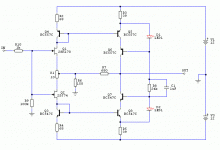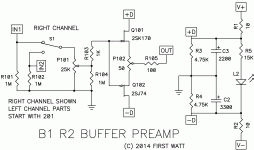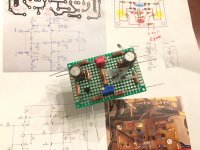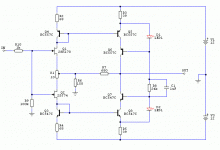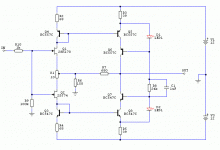I have listened with this pre for a few days and compared it to my BA'3 pre and I like the sound of the BA'3 somewhat better. Not a lot of difference both sound great but the BA'3 has a warmer smoother sounding vocal. It is probably that my BA'3 has more 2nd harmonic whereas the j-fet pre does not. From others descriptions of 2nd vs 3rd this seems to be the case. The j-fet pre is quick solid but dry sounding with vocals vs the BA'3. I do not have the expertise or equipment to play with the amounts of 2nd vs 3rd harmonic distortion as other more talented members here do. I did use P3 with the BA'3 using my ears to find what I considered best sounding. I wish it were a way with this
j-fet pre to add a pot where I could do the same. Anyone with some suggestions?
j-fet pre to add a pot where I could do the same. Anyone with some suggestions?
I have not received any suggestions so I proceeded today on my own. The worst that could happen would be smoke, fire or small explosion and I have already seen all three before. I removed R9 from both channels and replaced it with a 5K pot. I tied two leads together and set the pot to 4.7K in both channels. I then listened to music with one speaker at a time while turning the pot. First one way then the other until I was satisfied with what I was hearing. I do not have a distortion analyzer and the scope I do have does not see much use but I do still have pretty good hearing. This J-fet pre now sounds much the same as the BA-3 pre I also have. I cannot tell any difference between the two. Both sound great and I had fun building and playing with it.
I am learning how to appreciate how good this pre is. I have close to if not more than 20 different amps, tube and SS and all the ones I have tried this simple pre with have sound better in a different way than what I am used to. Different in that it is so quick with explosive bass even with a SET I tried it with last nigh. Crystal clear sound with lovely vocals. I also have a number of preamps to compare it with. As most know when you reach a certain point of good the differences become more subtle but this build is a worthy build for those interested in a very good preamplifier. I can appreciate lovely lush vocals tube pres and SET's produce but I can also appreciate what this preamplifier brings to the table as well. A perfect match for my super quick dynamic V-fet amplifier.
I played with the idea to use the current mirror instead of resistor/CCS in the BAF 2013 preamp circuit and I protyped attached circuit. Besides current mirror I decided to introduce the feedback loop (R7/R6, sets the gain to about 3,5V/V i.e. 11 dB).
The preamp now sounds (I think) a little bit better, the Zout is lower (about 270R, due to the feedback) so the bufer is not needed for most of the systems.
DC offset is behaving better too. With +/-12V PSU this pre will swing about 10V_peak at the output.
I used the JFETs with Idss of 7.5 and 9 mA and after setting the DC offset with P1 the Id through them is about 7mA and 11mA flows through the folded cascode (Q6/Q7). JFETs with other Idss values can be used but then R3/R5 have to be changed in order to set at least 10mA through Q6/Q7 (there is also about 1 mA going through LEDs).
Anyway, I think it's worth a try.
I am interested in building. The BC557C is obsolete. What can be used as a substitute. Also what size cap would I need at the output to stop DC for tube use.
Attachments
Last edited:
BC550c/560c
1uF - 10uF for amp's Zin of 100k - 10k
Thanks
I finished building Juma's latest schematic today on a perfboard. It went together fairly easy with only one wiring error on my part which is never any fun finding on a perfboard build but I found it. Great sounding right from the get go. I only have it in a plastic shoe box test setup I use for pre builds right now so it is nothing to look at but if anyone is interested I can take a picture or two. The original LSK schematic I built took 20 to 30 hours for it to settle in and start sounding best. I expect this one to only get better with a few hours on it. I decided not to use output caps since I will probably only use it for my new F4 I finished last month. Plenty enough gain for my horns with the F4.
Thanks Juma for sharing.
Thanks Juma for sharing.
I thought I would mention I am using a $10 24V switcher I bought on Ebay for power and using Papa's B1 R2 trick to make 12V + and - with ground. Quiet with 103db horns. Makes it a cheap build for a diyer.
Update on the $10 switcher. It was quite with the F4 but when I tried it with my other amps it was too noisy. I replaced it with a Meanwell switcher and it is now acceptable. This pre deserves a proper PS so I am going to build a regulated transformer powered PS for it.
24V switcher I bought on Ebay for power and using Papa's B1 R2 trick to make 12V + and - with ground
So the circuit takes 24v+ and divides it down to +/-12V? Is that how it works?
If I were to take +18v, would the circuit divide it down to +/-9v?
Thanks,
Vince
Use the B1 R2 trick of Nelson's. Switchers do not have a CT or what is called ground so you make one with this circuit. With a 24V source you will have +12V and -12V and a ground. This comes in handy when testing circuits with a switcher before building a proper PS. If you measure between D+ and D- you still have 24V but in reference to ground 12V.
Attachments
Last edited:
I played with the idea to use the current mirror instead of resistor/CCS in the BAF 2013 preamp circuit and I protyped attached circuit. Besides current mirror I decided to introduce the feedback loop (R7/R6, sets the gain to about 3,5V/V i.e. 11 dB).
The preamp now sounds (I think) a little bit better, the Zout is lower (about 270R, due to the feedback) so the bufer is not needed for most of the systems.
DC offset is behaving better too. With +/-12V PSU this pre will swing about 10V_peak at the output.
I used the JFETs with Idss of 7.5 and 9 mA and after setting the DC offset with P1 the Id through them is about 7mA and 11mA flows through the folded cascode (Q6/Q7). JFETs with other Idss values can be used but then R3/R5 have to be changed in order to set at least 10mA through Q6/Q7 (there is also about 1 mA going through LEDs).
Anyway, I think it's worth a try.
Hi Juma,
I am giving this one a try. Looks promising for the Pass F5.
I have never used current mirrors before. Do the current mirror BJTs need to be tightly matched? I have a good match among the P side and N side but the N parts don't match the P parts (500 HFE vs 525 HFE). Also, do the BJTs need to be matched channel to channel?
Better match the LED's too?
Attachments
Matching would be nice but not crucial, say 10% or so is ok. Jfets and bjts both, between the channels too. Trim pot will set the dc ofset at the output, thermal coupling will help but it will work fine without it once you close it in the box.
Symmetry can also be achieved by slightly changing the degenerating resistors in current mirrors.
Leds should be of the same type (3mm red) and they'll be matched enough by themselves..
Current through jfets will be set by their Idss and source degeneration and copied to bjt stage by current mirror - that current can be increased to wanted 10-15 mA by decreasing the current mirror degeneration in that branch.
Measure and listen and don't fret about some dc ofset at the output - use coupling cap before you close it in the case.
Symmetry can also be achieved by slightly changing the degenerating resistors in current mirrors.
Leds should be of the same type (3mm red) and they'll be matched enough by themselves..
Current through jfets will be set by their Idss and source degeneration and copied to bjt stage by current mirror - that current can be increased to wanted 10-15 mA by decreasing the current mirror degeneration in that branch.
Measure and listen and don't fret about some dc ofset at the output - use coupling cap before you close it in the case.
Matching would be nice but not crucial, say 10% or so is ok. Jfets and bjts both, between the channels too. Trim pot will set the dc ofset at the output, thermal coupling will help but it will work fine without it once you close it in the box.
Symmetry can also be achieved by slightly changing the degenerating resistors in current mirrors.
Leds should be of the same type (3mm red) and they'll be matched enough by themselves..
Current through jfets will be set by their Idss and source degeneration and copied to bjt stage by current mirror - that current can be increased to wanted 10-15 mA by decreasing the current mirror degeneration in that branch.
Measure and listen and don't fret about some dc ofset at the output - use coupling cap before you close it in the case.
Thanks Juma. Yes, Iam hoping it’s dc stable but I have some nice film caps I can use if it’s not.
I plan to first try it as a line preamp and maybe later add some lateral fets like cubie to use it as a headphone amp. I have ba3 front end and Salas’ DCG3 as well but I want to try something with less current as the Pass F5 has a 100k input and doesn’t need all that current. Thanks again.
- Home
- Amplifiers
- Pass Labs
- LSK pre - BAF 2013

